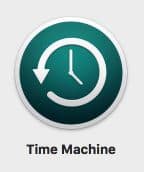Apple Time Machine Review
Time Machine is the go-to backup solution for most Apple fans, but the cloud offers just too many benefits to recommend this prepackaged, hardware-based program.
For many macOS users, Apple’s native backup software, Time Machine, is the first and last line of hard-drive failure defense. And why not? It’s easy to use, quickly and thoroughly protects your files, all for free.
However, while Time Machine may get the job done, its reliance on local storage means you won’t be taking advantage of the cloud. That means missing out on the level of protection you get by having your data stored RAID servers in a hardened data center.
Strengths & Weaknesses
Strengths:
- File previews
- Local backup
- Versioning
- Free
Weaknesses:
- No cloud backup
- Limited features
- Can’t schedule backups
- Less secure than cloud
Alternatives for Apple Time Machine
- 1
- :
- :
- :
- :
- :
- :
- :
- 2
- :
- :
- :
- :
- :
- :
- :
- 3
- :
- :
- :
- :
- :
- :
- :
- 4
- :
- :
- :
- :
- :
- :
- :
- 5
- :
- :
- :
- :
- :
- :
- :
Features
Time Machine is about as featureless as a backup tool can get. For many users, that will be just fine; for others, it will be a reason to consider switching to a more full-featured backup tool like CloudBerry Backup or even Duplicati (check out our CloudBerry Backup review or Duplicati review for more on these two services).
Perhaps the biggest missing feature is that Time Machine doesn’t backup to the cloud. It’s for local storage only. Additionally, it doesn’t let you create your own backup schedule. You can either go with automatic or manual backups and that’s it.
10,000+ Trust Our Free Cloud Storage Tips. Join Today!
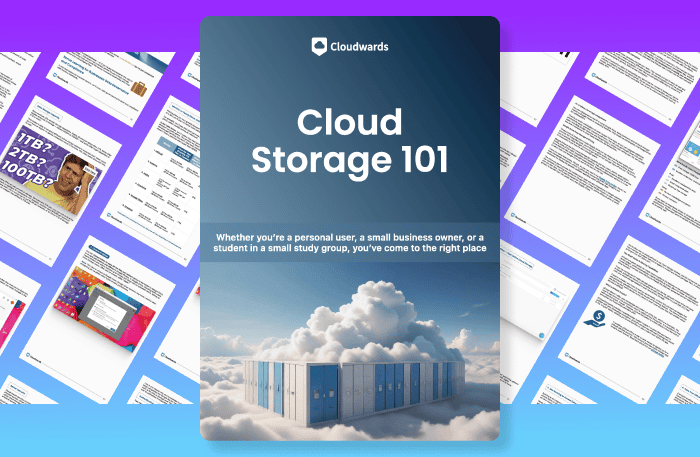
- Demystify cloud storage terminology and key concepts in plain language
- Discover easy-to-implement techniques to securely backup and sync your data across devices
- Learn money-saving strategies to optimize your cloud storage costs and usage
One area where Time Machine does overtake most backup options is that it backs up all files, including system files. While this is great, an option to only backup certain file types would be welcome as excluding files is a manual, tedious process.
Aside from destination and automatic or manual backup, the only other real option you get with Time Machine is whether or not to encrypt files that get backed up.
Pricing
Apple Time Machine is free with macOS. However, you do need to purchase local storage. One popular pick for this is Apple’s own brand of WiFi-enabled storage, Time Capsule.
Some brands of network-attached storage (NAS) are also compatible with Time Machine, or you can go with a external hard drive that uses a USB connection.
Ease of Use
Time Machine comes pre-installed on macOS and, as we’ll discuss in the File Backup section, below, is mostly automated. The only thing you really need to do start backing up your hard drive is pick a backup location.
Time Machine backs up all files, including system files, by default. For that reason, there’s very little maintenance involved unless you want to limit what objects are protected.
If you have a local drive without much space, you may find you need to do so, in which case you’ll have your work cut out for you because you have to exclude every single individual object you don’t want backed up. It would be better if Time Machine gave you the option to exclude objects by file type.
The tools itself is pretty plain, but it doesn’t really require any complexity considering what little it can do.
File Backup & Restoration
Click on Time Machine to get started setting up your backup plan. The first thing it will ask you to do is select a backup destination.
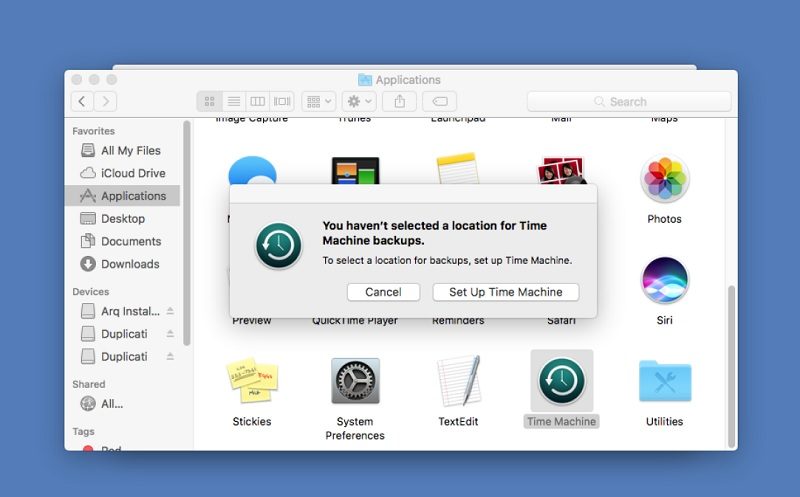
The Time Machine application will launch.
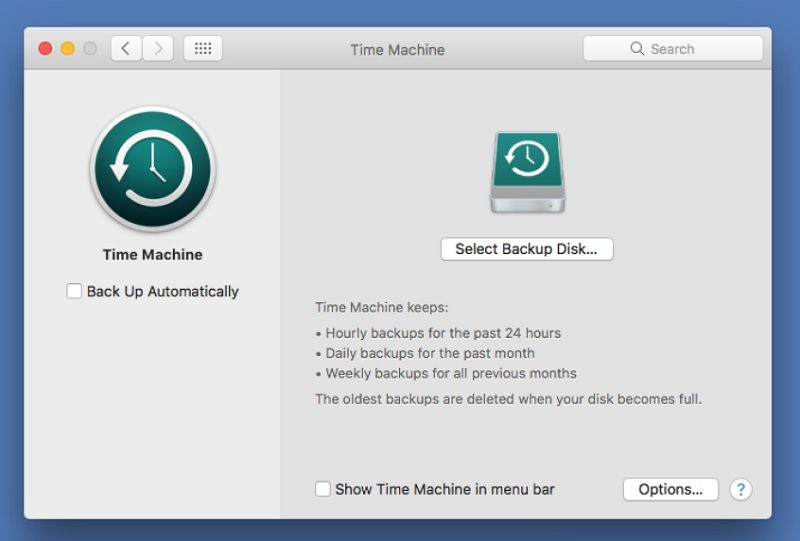
Make sure you either have a local drive (formatted for Mac) plugged into your computer or, if you want to get fancy, have connected to an Apple Time Capsule. Time Capsule’s are Apple’s own brand of local storage. They come in 2TB and 3TB sizes and connect using WiFi. The also work with iOS devices, Apple TV and Windows PC.
Time Machine doesn’t give you the option of saving to the cloud. That’s a pretty big disadvantage when compared to services like CloudBerry Backup, which let you select from about fifty different cloud storage integrations, including Dropbox, Google Drive, Amazon S3 and Backblaze B2.
Once you’ve picked a backup location, Time Machine will start backing your data up.
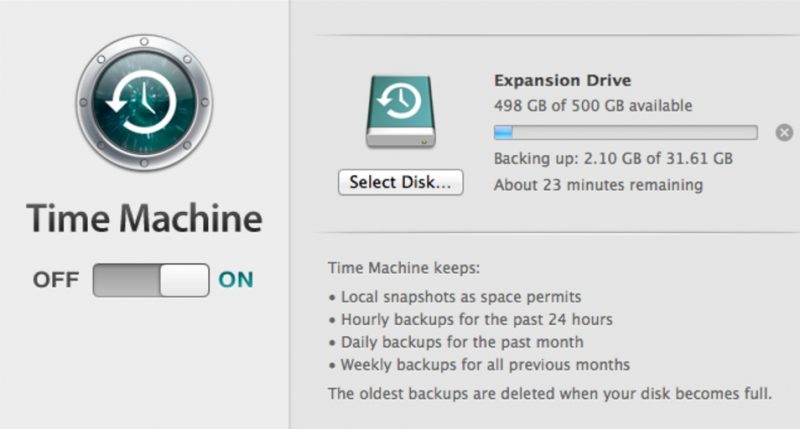
That first backup will take quite a bit of time, though will be faster than backing up to the cloud. Once completed, Time Machine will run in the background and perform automatic backups.
Time Machine retains hourly backups for the previous 24 hours, daily backups for the previous 30 days and weekly backups for all previous months. Backups are incremental, so only files only get backed up again if they’ve changed.
If your drive fills up, Time Machine will automatically delete the oldest backups. For this reason, you should consider going with an external drive that’s substantially larger than your hard drive.
You can also backup manually at any give time and shut automatic backups off entirely.
When restoring files, you can select the most recent version or past versions, if available. Time Machine may also include snapshots stored on your device’s hard drive. You can use these to restore from if you don’t have immediate access to your hard drive.
Prior to restoring a file, you can hit the spacebar to preview it and make sure its what you want.
Alternatively, you can restore everything you’ve backed up at once from macOS Recovery.
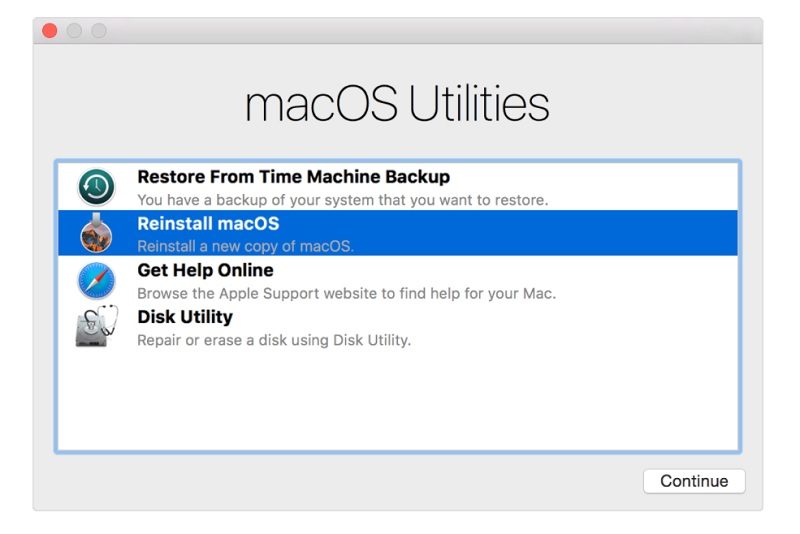
You can also copy files to another Mac using the “migration assistant.”
Security
There’s really not much to say about Time Machine security, as its going to as safe as you keep your local drive. That said, we can say that as a rule, local drives aren’t the best means of securing your data.
They’re easy to steal and damage. Cloud storage services like Backblaze, meanwhile, house your data in secure data centers designed to prevent both physical and virtual theft.
Additionally, cloud servers generally offer RAID infrastructure, meaning your files are stored on multiple servers for redundancy. That way, if a disk crashes, you don’t lose your data. The only way to get that level of protection for Time Machine is to purchase a RAID storage device.
The only security feature you get with Time Machine is an encryption toggle that you can switch on or off. Doing so will encrypt your files before sending them to your local drive.
Support
Apple maintains a support portal just for Time Machine. There, you’ll find guides for getting started and troubleshooting. There’s no way to search articles, but you don’t really need to: there aren’t that many to browse. What is available is at least well written.
If you can’t find the answers to your questions, you can contact Apple support, which is actually quite good. Help channels include telephone and live chat. The only real issue is that you have to go through a branching wizard to actually get to those channel and there’s no clear path for Time Machine.
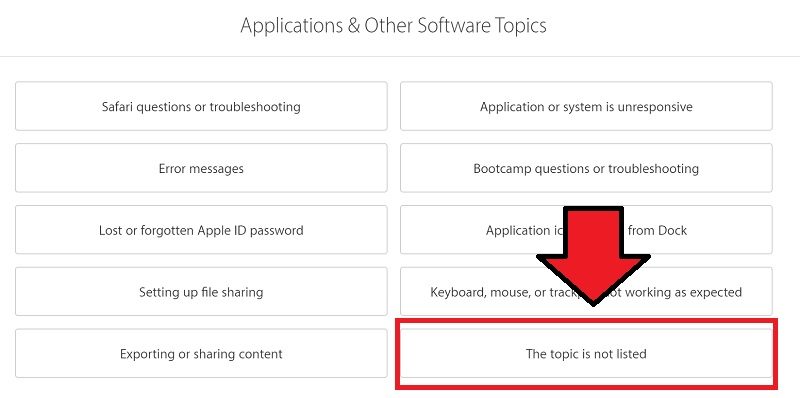
Once you do get to page that lets you choose live support, wait times aren’t long at all. We performed our tests on a Saturday afternoon, and live chat waits were five minutes. Telephone support waits were two.
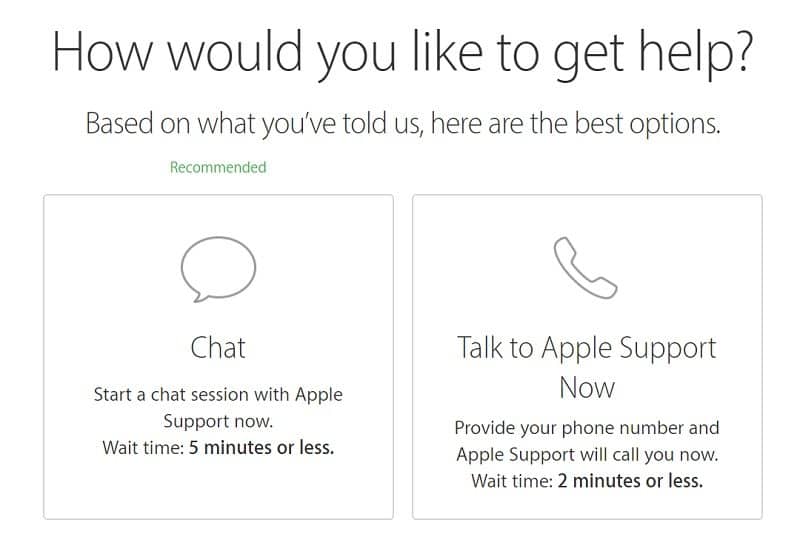
Apple also has a user forum and, of course, you could always visit your local Apple place of worship.
The Verdict
If you have zero interest in backing up the cloud and feel like splurging on an Apple Time Capsule, there are relatively few reasons not to use Time Machine. It’s free and relatively easy to use.
Backups are performed automatically and incrementally every hour by default, and most Apple computers pack enough horsepower that the process shouldn’t hamper your YouTube streaming.
If you’ve embraced the value of online backup services, however, you might want to consider a more feature-rich tool like CloudBerry Backup, which supports both local and cloud backup.
If you want to use both Time Machine and backup to the cloud, we’d recommend giving Backblaze a look. It only costs $5 a month, gives you unlimited backup space and backs up by file type. Its simplicity makes it great pairing with Time Machine.
That’s all we have to say on the topic of Apple Time Machine. We’re not huge fans, but it gets the job done. We welcome your own thoughts on the subject in the comments below. Thanks for reading.

